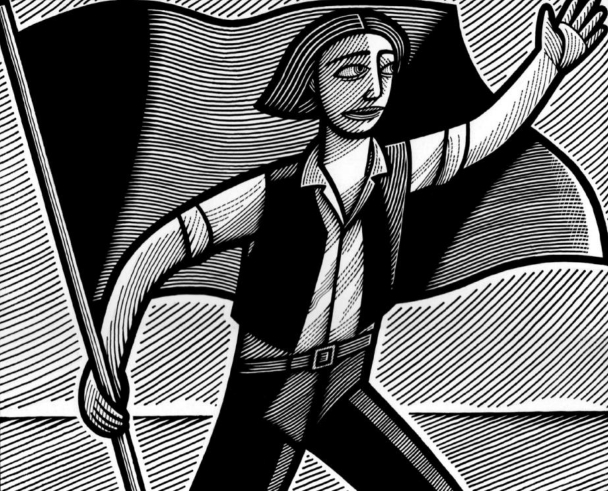Great Anarchists by Ruth Kinna and Clifford Harper on Dog Section Press, 2020
– book review by John de Plume
Comrades enduring the ongoing Tory disaster that has been 2020, may well be finding themselves hungry for inspirational reading material on thinkers who told the state to go fuck itself and sought to organise a better life instead. Indeed, such a book on such a topic might well make the perfect winter solstice gift to give to comrades and friends, to liven up what may be turning out to be a grim looking winter. Fortunate, then, that Dog Section Press have recently published Great Anarchists – a collection of essays by professor of political theory, Ruth Kinna, surveying the life and work of ten thinkers of significance who have interpreted and explored notions of anarchism and freedom in various ways. This is all at the comradely price of just £6, and features the superb illustrations of militant anarchist Clifford Harper.
The book is not an introduction to anarchism as such. The reader’s knowledge of certain theoretical concepts such as collectivism, egoism and even anarchism itself are somewhat assumed, meaning that those readers new to such discussions may want to keep a Wikipedia tab open for reference as they go. The book is perhaps best suited to those activists and readers who already have a take on anarchist ideas and practice in the present, but want to further explore the history of the thinkers that have informed and shaped discussions around anarchism and its application over the centuries.
The great anarchists in question are carefully chosen for nuance. Indispensable figures in the anarchist canon such as Louise Michel and Mikhail Bakunin are included, their ideas fortified by the the addition of less obviously anarchist thinkers such as Oscar Wilde and William Godwin. Historically proto-anarchist writers such as Pierre-Joseph Proudhon are included, as are discussions on the multiform of anarchist revolutionary methods; this includes Errico Malatesta’s propaganda of the deed in the late 19th century, and Lucy Parsons’ labour organising in the early 20th. The strength of the book lies in its ability to successfully contrast each thinker’s ideas with the other. Accordingly, the expansive and sometimes conflicting theorisations of what anarchism should be, and what it means in action, are explored through Kinna’s observation of contradictory positions. This is most notable in the stark distinction found between Peter Kropotkin’s anarchist-communism and the theoretically opposite position found in Max Stirner’s individualist-anarchism. Kinna presents such differential debates from an undogmatic and objective perspective, allowing the reader to respond to these discussions on their own terms.
This is a book that explores the spectrum of anarchist tradition and debate through its careful curation of an eclectic range of anarchist thinkers. Nonetheless, the figure of Marx appears throughout. This is either in reference to the notorious Marx-Bakunin conflict in the First International in the 1870s, or through the book’s contrasting of anarchist libertarian traditions to authoritarian Marxist derivatives such as Marxism-Leninism. For those of us interested in advancing an anti-authoritarian, libertarian-Marxism, the historical relationships between differing forms of anarchism to differing forms of Marxism that is so briefly touched on by the book could be further expanded. Although this discourse is, understandably, beyond the ambitions of this collection, Kinna, whilst writing about Bakunin, acknowledges anarchism’s ‘complicated relationship’ with Marx. Bakunin, writes Kinna, rejects Marxist revolutionary methods but recognises ‘Marx’s genius as a social theorist’ (page 31).
With such dynamics between differing theorists in mind – and to approach radical theory more broadly as a perpetually evolving discussion – one asks where are the appropriate ideas and methods for the revolutionary today to be found? The revolution in Rojava, as in Chiapas, demonstrates the success found in a converging of Marxist and anarchist critiques and tactics. Contemporary discussions within autonomism and communisation theory, in turn, benefit from an approach which freely utilises and develops that which is useful to us in a writer’s work and experience – be it anarchist or Marxist – and dispenses with that which is not.
Radical theory today needs no gods, no masters. It needn’t be ossified by historical tradition or by factional isms. Approaching Great Anarchists in this spirit, the reader is reminded of the fact that we have centuries of radical thought and debate at our disposal. Be it anarchist or Marxist, we have a history of revolutionary action, its triumphs and losses, its various and sometimes paradoxical incarnations, and the lessons therein, at our disposal. Kinna writes of a ‘theoretical toolbox’ that we might obtain by ‘surveying the historical landscape of ideas and drawing on the resources it contains’ (page 5). Indeed; Great Anarchists is a welcome addition to the toolbox.
Great Anarchists is available now alongside a wide selection of seditious material from Dog Section Press, or from your favourite radical bookshop.



